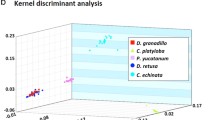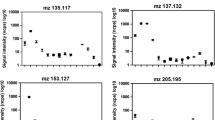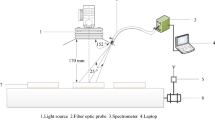Abstract
Using chemical fingerprints for timber species identification is a relatively new, but promising technique. However, little is known about the effect of pre-processing spectral data parameter settings on the timber species classification accuracy. Therefore, this study presents an extensive and automated analysis method using the random forest machine learning algorithm on a set of highly valuable timber species from the Meliaceae family. Metabolome profiles were collected using direct analysis in real-time (DART™) ionisation coupled with time-of-flight mass spectrometry (TOFMS) analysis of heartwood specimens for 175 individuals (representing 10 species). In order to analyse variability in classification accuracy, 110 sets of data pre-processing parameter combinations consisting of mass tolerance for binning and relative abundance cut-off thresholds were tested. Furthermore, for each set of parameters (designated “binning/threshold setting”), a random search for one hyperparameter of interest was performed, i.e. the number of variables (in this case ions) drawn randomly for each random forest analysis. The best classification accuracy (82.2%) was achieved with 47 variables and a binning and threshold combination of 40 mDa and 4%, respectively. Entandrophragma angolense is mostly confused with Entandrophragma candollei and Khaya anthotheca, and several Swietenia species are confused with each other due to the high similarity of their chemical fingerprints. Entandrophragma cylindricum, Entandrophragma utile, Khaya ivorensis, Lovoa trichilioides and Swietenia macrophylla are easy to discriminate and show less misclassifications. The choice of parameter settings, whether it is in the data pre-processing (binning and threshold) or classification algorithm (hyperparameters), results in variability in classification accuracy. Therefore, a preliminary parameter screening is proposed before constructing the final model when using the random forest algorithm for classification. Overall, DART-TOFMS in combination with random forest is a powerful tool for species identification.



Similar content being viewed by others
Change history
19 July 2021
A Correction to this paper has been published: https://doi.org/10.1007/s00226-021-01302-9
References
Beeckman H (2003) De microscopische schoonheid van mahonie (The microscopical beauty of mahogany). CR Interdisciplinair Tijdschrift Voor Conservering En Restauratie 4(2):18–27
Bergo MCJ, Pastore TCM, Coradin VTR, Wiedenhoeft AC, Braga JWB (2016) NIRS identification of Swietenia macrophylla is robust across specimens from 27 countries. IAWA J 37(3):420–430. https://doi.org/10.1163/22941932-20160144
Bergstra J, Bengio Y (2012) Random search for hyper-parameter optimization. J Mach Learn Res 13:281–305. https://doi.org/10.1162/153244303322533223
Beyramysoltan S, Giffen JE, Rosati JY, Musah RA (2018) Direct analysis in real time-mass spectrometry and Kohonen artificial neural networks for species identification of larva, pupa and adult life stages of carrion insects. Anal Chem 90:9206–9217. https://doi.org/10.1021/acs.analchem.8b01704
Braga JWB, Pastore TCM, Coradin VTR, Camargos JAA, da Silva AR (2011) The use of Near InfraRed Spectroscopy to Identify solid wood specimens of Swietenia Macrophylla (CITES Appendix II). IAWA J 32(2):285–296
Brunner M, Eugster R, Trenka E, Bergamin-Strotz L (1996) FT-NIR spectroscopy and wood identification. Holzforschung 50(2):130–134. https://doi.org/10.1515/hfsg.1996.50.2.130
Cody RB, Laramée JA (2005) Versatile new ion source for the analysis of materials in open air under ambient conditions. Anal Chem 77(8):2297–2302
Degen B, Ward SE, Lemes MR, Navarro C, Cavers S, Sebbenn AM (2013) Verifying the geographic origin of mahogany (Swietenia macrophylla King) with DNA-fingerprints. Forensic Sci Int Gen 7(1):55–62. https://doi.org/10.1016/j.fsigen.2012.06.003
Deklerck V, Finch K, Gasson P, Van den Bulcke J, Van Acker J, Beeckman H, Espinoza E (2017) Comparison of species classification models of mass spectrometry data: kernel discriminant analysis vs random forest; a case study of Afrormosia (Pericopsis elata (Harms) Meeuwen). Rapid Commun Mass Sp 31(May):1582–1588. https://doi.org/10.1002/rcm.7939
Dormontt EE, Boner M, Braun B, Breulmann G, Degen B, Espinoza E, Gardner S, Guillery P, Hermanson JC, Koch G, Lee SL, Kanashiro M, Rimbawanto A, Thomas D, Wiedenhoeft AC, Yin Y, Zahnen J, Lowe AJ (2015) Forensic timber identification: it’s time to integrate disciplines to combat illegal logging. Biol Conserv 191:790–798. https://doi.org/10.1016/j.biocon.2015.06.038
Espinoza EO, Lancaster CA, Kreitals NM, Hata M, Cody RB, Blanchette RA (2014) Distinguishing wild from cultivated agarwood (Aquilaria spp.) using direct analysis in real time and time of-flight mass spectrometry. Rapid Commun Mass Sp 28(3):281–289. https://doi.org/10.1002/rcm.6779
Evans PD, Mundo IA, Wiemann MC, Chavarria GD, McClure PJ, Voin D, Espinoza E (2017) Identification of selected CITES-Protected Araucariaceae using DART TOFMS. IAWA J 38(2):266–281
Finch K, Espinoza E, Jones FA, Cronn R (2017) Source identification of western Oregon Douglas-Fir wood cores using mass spectrometry and random forest classification. Appl Plant Sci 5(5):1–49. https://doi.org/10.3732/apps.1600158
Gasson P (2011) How precise can wood identification be? Wood anatomy’s role in support of the legal timber trade, especially CITES. IAWA J 32(2):137–154
Gillies ACM, Navarro C, Lowe AJ, Newton AC, Hernández M, Wilson J, Cornelius JP (1999) Genetic diversity in mesoamerican populations of mahogany (Swietenia macrophylla), assessed using RAPDs. Heredity 83(6):722–732. https://doi.org/10.1046/j.1365-2540.1999.00626.x
Hartvig I, Czako M, Kjær ED, Nielsen LR, Theilade I (2015) The use of DNA barcoding in identification and conservation of rosewood (Dalbergia spp.). PLoS ONE 10(9):e0138231. https://doi.org/10.1371/journal.pone.0138231
Hermanson JC, Wiedenhoeft A (2011) A brief review of machine vision in the context of automated wood identification systems. IAWA J 32(2):230–250
Höltken AM, Schröder H, Wischnewski N, Degen B, Magel E, Fladung M (2012) Development of DNA-based methods to identify CITES protected timber species: a case study in the Meliaceae family. Holzforschung 66(1):97–104. https://doi.org/10.1515/HF.2011.142
Jolivet C, Degen B (2012) Use of DNA fingerprints to control the origin of sapelli timber (Entandrophragma cylindricum) at the forest concession level in Cameroon. Forensic Sci Int Gen 6(4):487–493. https://doi.org/10.1016/j.fsigen.2011.11.002
Kagawa A, Leavitt SW (2010) Stable carbon isotopes of tree rings as a tool to pinpoint the geographic origin of timber. J Wood Sci 56(3):175–183. https://doi.org/10.1007/s10086-009-1085-6
Kasongo E, Louppe D, Monthe F, Hardy O, Mbele Lokanda FB, Hubau W, Van den Bulcke J, Van Acker J, Beeckman H, Bourland N (2019) Enjeux et amélioration de gestion de Entandrophragma: arbres africains potentiellement en danger (Management problems and improvements of Entandrophragma: African trees are potentially in danger). Bois et Forêts de Tropiques 339:75–94
Kuhn M (2018) Package classification and regression training (‘caret’). Repository CRAN, R package
Lancaster C, Espinoza E (2012) Analysis of select Dalbergia and trade timber using direct analysis in real time and time-of-flight mass spectrometry for CITES enforcement. Rapid Commun Mass Sp 26(9):1147–1156. https://doi.org/10.1002/rcm.6215
Leisch F, Dimitriadou E (2010) Package machine learning benchmark problems (‘mlbench’). Repository CRAN, R package
Lemes MR, Gribel R, Proctor J, Grattapaglia D (2003) Population genetic structure of mahogany (Swietenia macrophylla King, Meliaceae) across the Brazilian Amazon, based on variation at microsatellite loci: implications for conservation. Mol Ecol 12(11):2875–2883. https://doi.org/10.1046/j.1365-294X.2003.01950.x
Lemes MR, Dick CW, Navarro C, Lowe AJ, Cavers S, Gribel R (2010) Chloroplast DNA microsatellites reveal contrasting phylogeographic structure in mahogany (Swietenia macrophylla King, Meliaceae) from Amazonia and Central America. Trop Plant Biol 3(1):40–49. https://doi.org/10.1007/s12042-010-9042-5
McClure PJ, Chavarria GD, Espinoza E (2015) Metabolic chemotypes of CITES protected Dalbergia timbers from Africa, Madagascar, and Asia. Rapid Commun Mass Sp 29(9):783–788. https://doi.org/10.1002/rcm.7163
Monthe FS, Duminil J, Tosso F, Migliore J, Hardy OJ (2017) Characterization of microsatellite markers in two exploited African trees, Entandrophragma candollei and E. utile (Meliaceae). Appl Plant Sci 5(2):1600130. https://doi.org/10.3732/apps.1600130
Monthe FK, Duminil J, Kasongo Yakusu E, Beeckman H, Bourland N, Doucet J-L, Sosef MSM, Hardy OJ (2018) The African timber tree Entandrophragma congoense (Pierre ex De Wild.) A. Chev is morphologically and genetically distinct from Entandrophragma angolense (Welw.) C.DC. Tree Genet Genomes 14(5):66. https://doi.org/10.1007/s11295-018-1277-6
Musah RA, Espinoza EO, Cody RB, Lesiak AD, Christensen ED, Moore HE, Maleknia S, Drijfhout FP (2015) A high throughput ambient mass spectrometric approach to species identification and classification from chemical fingerprint signatures. Sci Rep 5(February):11520. https://doi.org/10.1038/srep11520
Novick RR, Dick C, Lemes MR, Navarro C, Caccone A, Bermingham E (2003) Genetic structure of Mesoamerican populations of Big-leaf mahogany (Swietenia macrophylla) inferred from microsatellite analysis. Mol Ecol 12(11):2885–2893. https://doi.org/10.1046/j.1365-294X.2003.01951.x
Paredes-Villanueva K, Espinoza E, Ottenburghs J, Sterken MG, Bongers F, Zuidema PA (2018) Chemical differentiation of Bolivian Cedrela species as a tool to trace illegal timber trade. Forestry 00:1–11. https://doi.org/10.1093/forestry/cpy019
Pastore TCM, Braga JWB, Coradin VTR, Magalhães WLE, Okino EYA, Camargos JAA, Bonzon de Muñiz GI, Bressan OA, Davrieux F (2011) Near infrared spectroscopy (NIRS) as a potential tool for monitoring trade of similar woods: discrimination of true mahogany, cedar, andiroba, and curupixá. Holzforschung 65(1):73–80. https://doi.org/10.1515/HF.2011.010
Price ER, McClure PJ, Jacobs RL, Espinoza EO (2018) Identification of rhinoceros keratin using direct analysis in real time time-of-flight mass spectrometry and multivariate statistical analysis. Rapid Commun Mass Spectrom 32:1–7. https://doi.org/10.1002/eqe.3063
Ravindran P, Costa A, Soares R, Wiedenhoeft AC (2018) Classification of CITES-listed and other neotropical Meliaceae wood images using convolutional neural networks. Plant Methods 14(1):1–10. https://doi.org/10.1186/s13007-018-0292-9
Rosa da Silva N, De Ridder M, Baetens JM, Van den Bulcke J, Rousseau M, Martinez Bruno O, Beeckman H, Van Acker J, De Baets B (2017) Automated classification of wood transverse cross-section micro-imagery from 77 commercial Central-African timber species. Ann For Sci 74(2):30. https://doi.org/10.1007/s13595-017-0619-0
Tnah LH, Lee SL, Ng KKS, Faridah Q-Z, Faridah-Hanum I (2010) Forensic DNA profiling of tropical timber species in Peninsular Malaysia. Forest Ecol Manag 259:1436–1446. https://doi.org/10.1016/j.foreco.2010.01.017
Tsuchikawa S, Inoue K, Noma J, Hayashi K (2003) Application of near-infrared spectroscopy to wood discrimination. J Wood Sci 49(1):29–35. https://doi.org/10.1007/s100860300005
UNEP-WCMC (n.d.) Convention on international trade in endangered species of Wild Fauna and Flora. Appendices I, II and III. Retrieved from https://cites.org/sites/default/files/notif/E-Notif-2016-068-A.pdf. Accessed 4 Jan 2019
Vlam M, de Groot GA, Boom A, Copini P, Laros I, Veldhuijzen K, Zakamdi D, Zuidema PA (2018) Developing forensic tools for an African timber: regional origin is revealed by genetic characteristics, but not by isotopic signature. Biol Conserv 220(January):262–271. https://doi.org/10.1016/j.biocon.2018.01.031
Acknowledgements
The authors would like to thank Stijn Willem (UGent-Woodlab), Pam McClure and Erin Price (US Fish and Wildlife Forensic Laboratory) for their help with the sample preparation. This research was conducted under the HerbaXylaRedd BELSPO-project (Brain.be – code: BR/143/A3/HERBAXYLAREDD). The findings and conclusions in the article are those of the authors and do not necessarily represent the views of the U.S. Fish and Wildlife Service.
Author information
Authors and Affiliations
Corresponding author
Ethics declarations
Conflict of interest
On behalf of all authors, the corresponding author states that there is no conflict of interest.
Additional information
Publisher's Note
Springer Nature remains neutral with regard to jurisdictional claims in published maps and institutional affiliations.
Electronic supplementary material
Below is the link to the electronic supplementary material.
Rights and permissions
About this article
Cite this article
Deklerck, V., Mortier, T., Goeders, N. et al. A protocol for automated timber species identification using metabolome profiling. Wood Sci Technol 53, 953–965 (2019). https://doi.org/10.1007/s00226-019-01111-1
Received:
Published:
Issue Date:
DOI: https://doi.org/10.1007/s00226-019-01111-1




